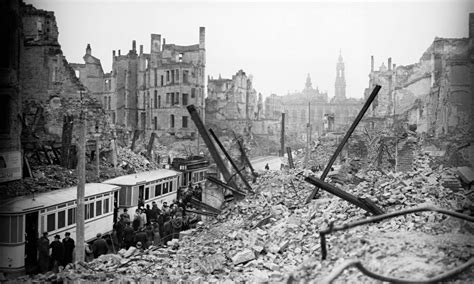Dresden, once known as the “Florence of the Elbe,” was a vibrant city renowned for its architectural beauty and cultural heritage. However, during the final months of World War II, the city became the target of a devastating bombing raid that forever altered its fate.

The Allied Bombing of Dresden
On February 13-14, 1945, the Royal Air Force (RAF) and the United States Army Air Forces (USAAF) launched a series of massive air raids on Dresden. The stated objective was to cripple Germany’s industrial output and transportation infrastructure.
However, the raids went beyond these military objectives. The indiscriminate bombing targeted civilian areas, including historical landmarks, churches, hospitals, and residential neighborhoods. The resulting firestorm consumed the city, creating a conflagration that spread over 15 square kilometers (5.8 square miles).
Casualties and Devastation
The exact number of casualties in the Dresden bombings remains disputed. German authorities initially estimated the death toll at 25,000, while the Allies claimed it was closer to 10,000. However, research conducted by the Dresden Historical Commission in 2010 indicated that the number of deaths was likely between 18,000 and 25,000.
The destruction of Dresden was catastrophic. The city’s historic center was virtually wiped out, including iconic landmarks such as the Frauenkirche (Church of Our Lady), the Zwinger Palace, and the Semper Opera House. Over 80% of the city’s buildings were destroyed or severely damaged, leaving thousands of people homeless.
Controversies Surrounding the Bombings
The Dresden bombings have sparked ongoing controversy over the ethics and legality of such attacks on civilian populations. Critics argue that the raids were unnecessary and disproportionate, and that they violated international laws governing warfare.
Defenders of the bombings maintain that they were justified as a necessary means of weakening Germany’s war effort and preventing further loss of life. They point to the fact that Dresden was a major transportation hub and industrial center, and that it had been previously designated as a legitimate military target.
The Legacy of Dresden
The destruction of Dresden had a profound impact on Germany and the world. It remains a symbol of the horrors of wartime destruction and the fragility of cultural heritage.
Reconstruction and Reconciliation
In the aftermath of the war, Dresden underwent a massive reconstruction effort. The Frauenkirche was rebuilt and reopened in 2005, serving as a testament to the resilience of the city and its people. Other historic landmarks have also been restored, and the city has become a vibrant cultural center once again.
In 2015, the Dresden Declaration was signed by representatives of Germany, the United Kingdom, and the United States. The declaration acknowledged the suffering caused by the bombings and called for reconciliation between the three nations.
Historical Significance
The Dresden bombings remain a significant event in European history. They have been the subject of numerous books, documentaries, and artistic works. The city’s role as a cultural center and its tragic fate have made it an emblem of the destruction and suffering that war can bring.
Conclusion
The bombing of Dresden was a tragedy that claimed thousands of lives and destroyed one of Europe’s most beautiful cities. The controversy surrounding the raids continues to this day, as historians and ethicists debate the justification for such attacks on civilian populations. However, the legacy of Dresden serves as a reminder of the importance of peace and reconciliation, and of the fragility of the treasures of human civilization.
